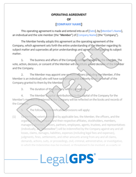Intellectual Property Assignment Agreements: The Ultimate Business Guide
When you’re building a business, protecting your intellectual property (IP) is one of the most important steps you can take. That’s where an...
6 min read
LegalGPS : Jul. 26, 2024
In the ever-evolving world of business, strategic partnerships and collaborations have become common as companies leverage collective strengths to accelerate growth. Amidst these collaborations, Intellectual Property Joint Venture Agreements stand as a critical legal backbone, particularly in tech-oriented or innovation-focused sectors.


Legal GPS Pro
Protect your business with our complete legal subscription service, designed by top startup attorneys.

Intellectual Property Joint Venture Agreement
A legal contract establishing a joint venture to collaboratively develop manage and protect intellectual property assets.
Trusted by 1,000+ businesses to safeguard their LLCs.
An Intellectual Property (IP) Joint Venture Agreement outlines the details of a partnership between two or more entities that agree to combine their intellectual property to achieve a specific business goal. For example, a company may enter into a joint venture with a startup to develop and market new technology. The agreement would outline how the IP is shared between the two companies, as well as any royalties or licensing fees that would be due upon commercialization.
Ultimately, the aim of an IP Joint Venture Agreement is to ensure that each party's intellectual assets—copyrights, patents, trademarks, and trade secrets— used in the joint venture are protected, and the benefits derived from them are fairly shared.
Joint ventures often facilitate the acceleration of innovation, by allowing entities to leverage shared knowledge, resources, and risk. However, such collaborative initiatives also come with the potential for disputes, often revolving around intellectual property rights. Hence, clear and comprehensive IP Joint Venture Agreements emerge as a compelling necessity.
Having a well-structured agreement goes a long way in:
Defining the rights, roles, responsibilities, and obligations of each party
Establishing the procedures for managing IP
Providing clear mechanisms for conflict resolution
Outlining the terms for revenue sharing
Now that we understand the importance of the Intellectual Property Joint Venture Agreement, let's dive into crafting one. Follow these clear and actionable steps to create a legally sound document that safeguards both parties' interests.
Start by outlining the parties involved in the joint venture. Be sure to include their full legal names, business addresses, and their roles in the collaboration. They would typically be referred to as "Party A" and "Party B" throughout the agreement.
Parties involved: The agreement must clearly state the names, identities, and roles of the involved parties.
Purpose of the Joint Venture: Clear articulation of the joint venture’s purpose, objective, and the duration it is expected to last.
Intellectual Property Provision: Define the type of intellectual property involved, who its original owner is, and the permissions granted to the other party regarding its use.
Profit and Loss provision: Clearly layout the distribution of profits, losses, and other financial rules.
Management and Control Clause: Establish the rules regarding who will manage operations, make decisions, and how disagreements will be resolved.
Clearly express the goal of the joint venture and its objectives to ensure that all parties are working towards a common mission. Include the industry, specific project details, and the expected duration of the collaboration.
In this section, describe the assets that each party is contributing. You should include:
Intellectual property: Detail the specific copyrights, patents, trademarks, or trade secrets being contributed.
Capital contributions: List any financial investments or resources being committed to the venture.
Non-monetary contributions: Outline any non-financial contributions, such as labor, equipment, expertise, or facilities.
Clarify the ownership of any existing or newly developed intellectual property. Specify which party retains the original ownership, which party has the license to use the IP, and any limitations or exclusions attached to that license. Also, identify procedures for handling potential infringements by third parties.
Prevent Copycats With Patents, Trademarks, and Copyrights
This part of the agreement should address the management structure and decision-making in the joint venture, outlining:
The composition of the management team or board
The powers and responsibilities of each member
Procedures for making significant decisions
Mechanisms for resolving disputes or deadlocks
Now, divide the financial aspects of the joint venture, such as:
Profit and loss sharing: Clearly state each party's percentage share in profits, losses, and expenses.
Liability distribution: Explain how any potential liabilities resulting from the joint venture will be shared.
Consider including terms to protect sensitive and confidential information related to the joint venture, such as:
Defining what constitutes confidential information
Setting rules and restrictions around disclosing confidential information
Outlining any non-competition or non-solicitation clauses
Prepare for the end of the joint venture by addressing:
Causes for termination and the procedures involved
The division of assets and transferring of rights upon termination
Any non-compete clauses that may remain in effect after termination
Dispute resolution mechanisms, such as mediation or arbitration
Give the document a thorough review, ensuring all the discussed points are accurately captured and the terms are clear. Finally, have each party sign the agreement in the presence of a witness or legal professional for proper documentation.
While this step is optional, it is always recommended to have a legal professional review the agreement before finalizing. This extra security can help avoid potential disputes or legal issues down the road.
There you have it! By following these steps, you'll create a well-drafted and legally sound Intellectual Property Joint Venture Agreement that paves the way for a successful collaboration. Remember, you can always click here to access our contract templates to save time and get started quickly.


Legal GPS Pro
Protect your business with our complete legal subscription service, designed by top startup attorneys.
While it may seem a straightforward process once you’ve read the steps, drafting an Intellectual Property Joint Venture Agreement—to be precise, drafting an effective one—is a meticulous task where many common mistakes can occur. So, let's review some of these common traps and how to avoid them, in an effort to ensure that your agreement stands on a solid legal foundation.
Unclear definitions can lead to disputes down the line. When outlining the purpose and objectives of the joint venture, be as clear and precise as possible. Detail the nature of the industry, specific project details, and the expected duration for the collaboration.
Any intellectual property involved in the joint venture, whether it’s a patent, copyright, trademark, or trade secret, needs to be explicitly mentioned. The agreement must also clarify how these rights are being transferred or licensed, and the constraints on their use. Do not overlook this part, as ambiguity can lead to disputes or misuse down the line.
Even in the best of collaborations, differences can arise. Be prepared by having a clear, pre-defined mechanism for resolving disputes. Specify whether disputes will be dealt with through litigation, arbitration, or mediation. Having a plan in place can help save time, expenses, and relationships.
Exit strategies are often overlooked, but they are a crucial part of any IP Joint Venture Agreement. Define the grounds for exit, the process of termination, and how the assets or intellectual rights will be divided after a termination. Being clear about this from the beginning saves headaches later on.
Get Your Intellectual Property Joint Venture Agreement Template
with a Legal GPS Subscription
Remember to safeguard your confidential business information. Include clear terms around handling and disclosing confidential information. Consider setting provisions about non-competition and non-solicitation during—and also after—the joint venture.
A common misconception is that legal documents should use complex jargon. In reality, the best legal documents are usually written in plain English. Clear communication can help ensure that all parties are on the same page and prevent misunderstandings.
Avoiding these common mistakes can put you on a path to crafting a well-rounded IP Joint Venture Agreement, that adequately addresses potential risks and situations, and makes sure you’re legally guarded and prepared for the journey ahead. As always, though not mandatory, consulting a legal professional for a final review can help ensure that your agreement is legally robust.

Intellectual Property Joint Venture Agreement
A legal contract establishing a joint venture to collaboratively develop manage and protect intellectual property assets.
Trusted by 1,000+ businesses to safeguard their LLCs.
Without an explicit IP joint venture agreement, parties in a joint venture might find themselves in heated disputes, often leading to expensive legal battles, which have the potential to harm the company's image, profitability, and growth.
From protecting intellectual property rights, ensuring that all parties are working towards the same goals, to protecting partners from potential liabilities; an effective Intellectual Property Joint Venture Agreement provides a solid structure to your joint venture, ensuring that the road to collaborative success remains smooth and legally protected.
In the world of businesses fostering innovation through collaboration, an Intellectual Property Joint Venture Agreement remains as an essential legal tool - a tool allowing the amalgamation of ideas and assets, whilst ensuring that each party's intellectual property rights and interests are protected.
Ready to protect your future joint venture with a legally sound Intellectual Property Joint Venture Agreement? Click here to access our meticulously drafted, lawyer-reviewed contract templates designed to protect your corporate interests while saving you time and money.
Get Legal GPS's Intellectual Property Joint Venture Agreement Template Now
The biggest question now is, "Do I need a business lawyer?” For most businesses and in most cases, you don't need a lawyer to start your business. Instead, many business owners rely on Legal GPS Pro to help with legal issues.
Legal GPS Pro is your All-In-One Legal Toolkit for Businesses. Developed by top startup attorneys, Pro gives you access to 100+ expertly crafted templates including operating agreements, NDAs, and service agreements, and an interactive platform. All designed to protect your company and set it up for lasting success.

Legal GPS Pro
Protect your business with our complete legal subscription service, designed by top startup attorneys.
|
Premium Template
Single-use Template |
Legal GPS Pro
Unlimited Access, Best Value |
|
|
| Choose Template | Learn More |
| Trusted by 1000+ businesses | |

When you’re building a business, protecting your intellectual property (IP) is one of the most important steps you can take. That’s where an...

Startups are the lifeblood of innovation, powering economic growth through their disruptive ideas and solutions. However, in the race to market, many...

As an entrepreneur, one of your most valuable assets is your company's intellectual property (IP). From trade secrets and customer lists to patented...